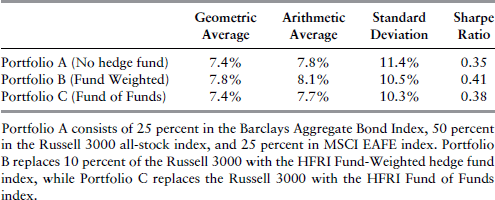HEDGE FUNDS IN A PORTFOLIO
Table 9.7 reports on a diversification experiment where an investor shifts from an all-traditional portfolio to a portfolio that includes 10 percent investment in hedge funds. The traditional portfolio (A) consists of 25 percent in the Barclays Aggregate U.S. bond index, 50 percent in the Russell 3000, and 25 percent in the MSCI EAFE index. Portfolio B shifts 10 percent of the U.S. stock investment into the HFRI Fund-Weighted Index. Portfolio C shifts 10 percent of the U.S. stock investment into the HFRI Fund of Funds index.
TABLE 9.7 Effects of Hedge Funds on Portfolio Performance, 1990–2009
Data Sources: HFRI, Barclays Capital, Russell®, and MSCI.

The most impressive results are obtained when the HFRI Fund-Weighted index is chosen as the hedge fund vehicle. The compound return on the portfolio is lifted by 0.4 percent and the Sharpe ratio is increased from 0.35 to 0.41. That translates into an alpha* of 0.6 percent. But investment in the fund of funds index also improves performance of the portfolio. The return on the portfolio is not increased, but the Sharpe ratio is increased from 0.35 to 0.38. That translates into an alpha* of about 0.3 percent. This is admittedly a very small improvement. In fact, Table 9.7 shows that hedge funds are not the wonder drug that some observers claim. But, according to these results, they do add to risk-adjusted performance. ...
Get Portfolio Design: A Modern Approach to Asset Allocation now with the O’Reilly learning platform.
O’Reilly members experience books, live events, courses curated by job role, and more from O’Reilly and nearly 200 top publishers.

